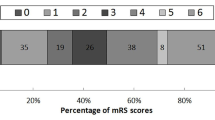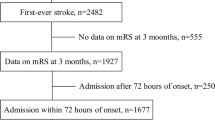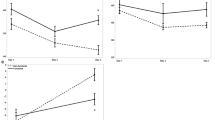Abstract
Background and purpose
We aimed to determine whether heart rate variability (HRV) was correlated to long-term outcome in patients who received mechanical thrombectomy (MT) under general anesthesia for emergent large vessel occlusion (ELVO).
Methods
Data from 106 patients receiving MT under general anesthesia to treat ELVO between January 1, 2017 and December 31, 2019 were collected in a multicenter chart review. Univariate analysis, Chi-square test, and bivariate logistic regression were performed to assess the correlations between preoperative risk factors such as HRV and long-term outcome (as indicated by the modified Rankin score [mRS] at 90 days after MT).
Results
Bivariate logistic regression revealed that decreased LF/HF (low frequency/high frequency in HRV) ratio was correlated with unfavorable functional outcome as indicated by mRS ≥ 2 (odds ratio [OR], 0.650; 95% confidence interval [CI], 0.157–0.839; p = 0.018), and functionally dependent outcome as indicated by mRS ≥ 3 (OR, 0.704; 95% CI, 0.360–0.914; p = 0.021). It was also found that ELVO in the right anterior circulation was correlated with lower LF/HF ratio, as compared with ELVO in the contralateral side (p < 0.05).
Conclusion
Our retrospective study demonstrated that worse outcome in patients with ELVO who received MT under general anesthesia induced autonomic changes and that decreased LF/HF ratio.


Similar content being viewed by others
References
Satti S, Chen J, Sivapatham T, Jayaraman M, Orbach D (2017) Mechanical thrombectomy for pediatric acute ischemic stroke: review of the literature. J Neurointerv Surg 9(8):732–737. https://doi.org/10.1136/neurintsurg-2016-012320
Mccarthy DJ, Theodotou C, Sur S, Snelling B, Chen S, Peterson EC, Starke RM (2017) Long-term outcomes of mechanical thrombectomy for treatment of acute ischemic stroke. World Neurosurg 104:970–971. https://doi.org/10.1016/j.wneu.2017.06.103
Brinjikji W, Murad MH, Rabinstein AA, Cloft HJ, Lanzino G, Kallmes DF (2015) Conscious sedation versus general anesthesia during endovascular acute ischemic stroke treatment: a systematic review and meta-analysis. AJNR Am J Neuroradiol 36(3):525–529. https://doi.org/10.3174/ajnr.A4159
Jadhav AP, Bouslama M, Aghaebrahim A, Rebello LC, Starr MT, Haussen DC, Ranginani M, Whalin MK, Jovin TG, Nogueira RG (2017) Monitored anesthesia care vs intubation for vertebrobasilar stroke endovascular therapy. JAMA Neurol 74(6):704–709. https://doi.org/10.1001/jamaneurol.2017.0192
Gerschenfeld G, Muresan IP, Blanc R, Obadia M, Abrivard M, Piotin M, Alamowitch S (2017) Two paradigms for endovascular thrombectomy after intravenous thrombolysis for acute ischemic stroke. JAMA Neurol 74(5):549–556. https://doi.org/10.1001/jamaneurol.2016.5823
Wang A, Stellfox M, Moy F, Abramowicz AE, Lehrer R, Epstein R, Eiden N, Aquilina A, Pednekar N, Brady G (2016) General anesthesia during endovascular stroke therapy does not negatively impact outcome. World Neurosurg 99:638–643. https://doi.org/10.1016/j.wneu.2016.12.064
Dütsch M, Burger M, Dörfler C, Schwab S, Hilz MJ (2007) Cardiovascular autonomic function in poststroke patients. Neurology 69(24):2249–2255. https://doi.org/10.1212/01.wnl.0000286946.06639.a7
Dorrance AM, Fink G (2015) Effects of stroke on the autonomic nervous system. Compr Physiol 5(3):1241–1263. https://doi.org/10.1002/cphy.c140016
Bosel J (2017) Blood pressure control for acute severe ischemic and hemorrhagic stroke. Curr Opin Crit Care 23(2):81–86. https://doi.org/10.1097/mcc.0000000000000394
Koppikar S, Baranchuk A, Guzman JC, Morillo CA (2013) Stroke and ventricular arrhythmias. Int J Cardiol 168(2):653–659. https://doi.org/10.1016/j.ijcard.2013.03.058
Krause T, Werner K, Fiebach JB, Villringer K, Piper SK, Haeusler KG, Endres M, Scheitz JF, Nolte CH (2017) Stroke in right dorsal anterior insular cortex is related to myocardial injury. Ann Neurol 81(4):502–511. https://doi.org/10.1002/ana.24906
Arai YC, Ushida T, Matsubara T, Shimo K, Ito H, Sato Y, Wakao Y, Komatsu T (2011) The Influence of acupressure at extra 1 acupuncture point on the spectral entropy of the EEG and the LF/HF ratio of heart rate variability. Evid Based Complement Alternat Med 2011:503698–503696. https://doi.org/10.1093/ecam/nen061
von Rosenberg W, Chanwimalueang T, Adjei T, Jaffer U, Goverdovsky V, Mandic DP (2017) Resolving ambiguities in the LF/HF ratio: LF-HF scatter plots for the categorization of mental and physical stress from HRV. Front Physiol 8:360. https://doi.org/10.3389/fphys.2017.00360
Kawiorski MM, Martinez-Sanchez P, Garcia-Pastor A, Calleja P, Fuentes B, Sanz-Cuesta BE, Lourido D, Marin B, Diaz-Otero F, Vicente A, Sierra-Hidalgo F, Ruiz-Ares G, Diez-Tejedor E, Fandino E, Alonso de Lecinana M (2016) Alberta Stroke Program Early CT Score applied to CT angiography source images is a strong predictor of futile recanalization in acute ischemic stroke. Neuroradiology 58(5):487–493. https://doi.org/10.1007/s00234-016-1652-7
Puetz V, Sylaja PN, Coutts SB, Hill MD, Dzialowski I, Mueller P, Becker U, Urban G, O’Reilly C, Barber PA, Sharma P, Goyal M, Gahn G, von Kummer R, Demchuk AM (2008) Extent of hypoattenuation on CT angiography source images predicts functional outcome in patients with basilar artery occlusion. Stroke 39(9):2485–2490. https://doi.org/10.1161/strokeaha.107.511162
Zhang LM, Li R, Zhao XC, Zhang Q, Luo XL (2017) Increased transfusion of fresh frozen plasma is associated with mortality or worse functional outcomes after severe traumatic brain injury: a retrospective study. World Neurosurg 104:381–389. https://doi.org/10.1016/j.wneu.2017.04.140
Heart rate variability: standards of measurement, physiological interpretation and clinical use. Task Force of the European Society of Cardiology and the North American Society of Pacing and Electrophysiology (1996). Circulation 93 (5):1043-1065
Pan J, Tompkins WJ (1985) A real-time QRS detection algorithm. IEEE Trans Biomed Eng 32(3):230–236. https://doi.org/10.1109/tbme.1985.325532
Zhang LM, Li R, Zhao XC, Wang ML (2017) Decreased tidal volume with increased height, but not colloid transfusion, is associated with worse outcomes and postoperative pneumonia after coil embolization of aneurysmal subarachnoid hemorrhage: a retrospective study. Shock 50(4):421–426. https://doi.org/10.1097/SHK.0000000000001095
Zhang LM, Li R, Zhao XC, Wang ML, Fu Y (2018) The relationship between colloid transfusion during surgical decompression hemicraniectomy period and post-operative pneumonia or long-term outcome after space-occupying cerebral infarction: a retrospective study. World Neurosurg 122:e1312–e1320. https://doi.org/10.1016/j.wneu.2018.11.041
Campbell BCV, van Zwam WH, Goyal M, Menon BK, Dippel DWJ, Demchuk AM, Bracard S, White P, Davalos A, Majoie C, van der Lugt A, Ford GA, de la Ossa NP, Kelly M, Bourcier R, Donnan GA, Roos Y, Bang OY, Nogueira RG, Devlin TG, van den Berg LA, Clarencon F, Burns P, Carpenter J, Berkhemer OA, Yavagal DR, Pereira VM, Ducrocq X, Dixit A, Quesada H, Epstein J, Davis SM, Jansen O, Rubiera M, Urra X, Micard E, Lingsma HF, Naggara O, Brown S, Guillemin F, Muir KW, van Oostenbrugge RJ, Saver JL, Jovin TG, Hill MD, Mitchell PJ (2018) Effect of general anaesthesia on functional outcome in patients with anterior circulation ischaemic stroke having endovascular thrombectomy versus standard care: a meta-analysis of individual patient data. Lancet Neurol 17(1):47–53. https://doi.org/10.1016/s1474-4422(17)30407-6
Luo G, Mo D, Tong X, Liebeskind DS, Song L, Ma N, Gao F, Sun X, Zhang X, Wang B (2018) Factors associated with 90-day outcomes of patients with acute posterior circulation stroke treated by mechnical thrombectomy. World Neurosurg 109:e318–e328. https://doi.org/10.1016/j.wneu.2017.09.171
Pfaff J, Herweh C, Pham M, Schönenberger S, Nagel S, Ringleb PA, Bendszus M, Möhlenbruch M (2016) Mechanical thrombectomy in patients with acute ischemic stroke and lower NIHSS scores: recanalization rates, periprocedural complications, and clinical outcome. AJNR Am J Neuroradiol 37(11):2066–2071. https://doi.org/10.3174/ajnr.A4862
Dargazanli C, Arquizan C, Gory B, Consoli A, Labreuche J, Redjem H, Eker O, Decroix JP, Corlobé A, Mourand I (2017) Mechanical thrombectomy for minor and mild stroke patients harboring large vessel occlusion in the anterior circulation: a multicenter cohort study. Stroke 48(12):3274–3281. https://doi.org/10.1161/STROKEAHA.117.018113
Alex AC, Ossama OZ, Alicia CC, Rishi G, Chung-Huan JS, Coleman OM, William EH, Nils MK, Joey DE, Italo L (2014) North American SOLITAIRE stent-retriever acute stroke registry: choice of anesthesia and outcomes. Stroke 45(5):1396–1401. https://doi.org/10.1161/STROKEAHA.113.003698
Son S, Kim YW, Min KO, Kim SK, Park KJ, Choi NC, Kwon OY, Lim BH, Choi HC, Choi DS (2015) Initial factors affecting the clinical outcome after successful recanalization via MR-based mechanical thrombectomy in patients with acute ischemic stroke due to basilar artery occlusion. J Neurointerv Surg 8(9):889–893. https://doi.org/10.1136/neurintsurg-2015-011912
Huo X, Gao F, Sun X, Ma N, Song L, Mo D, Liu L, Wang B, Zhang X, Miao Z (2016) Endovascular mechanical thrombectomy with the Solitaire device for the treatment of acute basilar artery occlusion. World Neurosurg 89:301–308. https://doi.org/10.1016/j.wneu.2016.02.017
Jayaraman MV, Mctaggart RA (2017) Endovascular treatment of anterior circulation large vessel occlusion in the elderly. Front Neurol 8:713. https://doi.org/10.3389/fneur.2017.00713
Sallustio F, Koch G, Motta C, Diomedi M, Alemseged F, D’Agostino VC, Napolitano S, Samà D, Davoli A, Konda D (2017) Efficacy and safety of mechanical thrombectomy in older adults with acute ischemic stoke. J Am Geriatr Soc 65(8):1816–1820. https://doi.org/10.1111/jgs.14909
Kaschka IN, Kloska SP, Struffert T, Engelhorn T, Gölitz P, Kurka N, Köhrmann M, Schwab S, Doerfler A (2016) Clinical and radiological outcome after mechanical thrombectomy in acute ischemic stroke: what matters. Neuroradiol J 29(2):99–105. https://doi.org/10.1177/1971400916628170
Heck DV, Brown MD (2015) Carotid stenting and intracranial thrombectomy for treatment of acute stroke due to tandem occlusions with aggressive antiplatelet therapy may be associated with a high incidence of intracranial hemorrhage. J Neurointerv Surg 7(3):170–175. https://doi.org/10.1136/neurintsurg-2014-011224
Qiu M, Sato S, Zheng D, Wang X, Carcel C, Hirakawa Y, Sandset EC, Delcourt C, Arima H, Wang J, Chalmers J, Anderson CS (2016) Admission heart rate predicts poor outcomes in acute intracerebral hemorrhage: the intensive blood pressure reduction in acute cerebral hemorrhage trial studies. Stroke 47(6):1479–1485. https://doi.org/10.1161/strokeaha.115.012382
Korpelainen JT, Sotaniemi KA, Huikuri HV, Myllyä VV (1996) Abnormal heart rate variability as a manifestation of autonomic dysfunction in hemispheric brain infarction. Stroke 27(11):2059–2063. https://doi.org/10.1161/01.str.27.11.2059
Meyer S, Strittmatter M, Fischer C, Georg T, Schmitz B (2004) Lateralization in autonomic dysfunction in ischemic stroke involving the insular cortex. Neuroreport 15(2):357–361. https://doi.org/10.1097/00001756-200402090-00029
Tokgözoglu SL, Batur MK, Topçuoglu MA, Saribas O, Kes S, Oto A (1999) Effects of stroke localization on cardiac autonomic balance and sudden death. Stroke 30(7):1307–1311. https://doi.org/10.1161/01.str.30.7.1307
Acknowledgments
Dr. Rui Li, Dr. Wen-Bo Sun, Dr. Yong-Chang Liu, and Dr. Wen-Gao Zhang in Cangzhou Central Hospital participated in editing the manuscript.
Availability of data and material
The datasets used and/or analyzed during the current study are available from the corresponding author on reasonable request.
Funding
This work was supported by Natural Science Foundation of China (No. 81701296), Programs of Science and Technology Commission Foundation of Hebei Province (No. 172777117).
Author information
Authors and Affiliations
Contributions
Design of the study: Li-Min Zhang
Editing the manuscript: Dong-Xue Zhang, Li-Min Zhang
Statistical analysis: Dong-Xue Zhang, Li-Min Zhang
Data collection: Dong-Xue Zhang, Xiao-Dong Wang, Yan-Chao Peng, Ming-Li Wang, Yue Fu
All authors read and approved the final manuscript.
Corresponding author
Ethics declarations
Competing interests
The authors declare that they have no competing interests.
Ethics approval and consent to participate
This study was retrospective and approved by the Regional Ethics Committee of our three hospitals (Cangzhou Central Hospital, Cangzhou People Hospital, and Cangzhou Second People Hospital).
Additional information
Publisher’s note
Springer Nature remains neutral with regard to jurisdictional claims in published maps and institutional affiliations.
Rights and permissions
About this article
Cite this article
Zhang, DX., Zhang, BX., Wang, XD. et al. Decreased LF/HF ratio is associated with worse outcomes in patients who received mechanical thrombectomy under general anesthesia for emergent large vessel occlusion: a retrospective study. Neurol Sci 42, 1453–1462 (2021). https://doi.org/10.1007/s10072-020-04682-1
Received:
Accepted:
Published:
Issue Date:
DOI: https://doi.org/10.1007/s10072-020-04682-1




